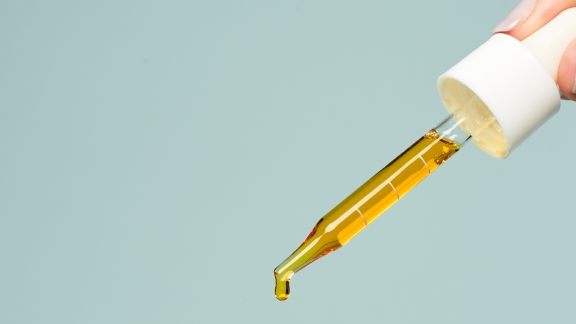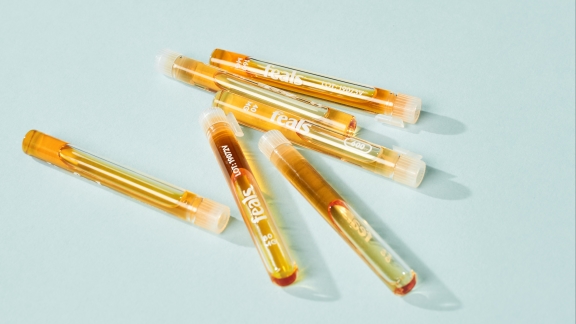CBD is new to a lot of us, but even still it’s popping up just about everywhere—in the latte at your coffee shop around the corner, in the fizzy drink at your bodega, in your face oil. You get the picture. And you might be a little skeptical—and rightfully so, it’s important to ask questions about what you’re putting into your body. While there’s tons of anecdotal evidence out there from people who have used CBD for various reasons, clinical research data is less available while science plays catch up. That said, there are a few things we do know for sure, and we’re going to walk you through some oft-circulated fallacies so you can make a more informed decision about whether or not it’s right for you.
Myth #1: CBD gets you high.
Not true. CBD is short for cannabidiol, and it’s one of over 113 active compounds found in the cannabis plant. CBD is the second most abundant cannabinoid found in cannabis just behind delta-9-tetra-hydrocannabinol (THC). Cannabis with less than 0.3% THC is now classified as hemp; instead of being rich in THC, CBD is usually the most abundant cannabinoid. So the difference between cannabis-derived CBD and hemp-derived CBD refers to the parent plant and whether or not it produced more than 0.3% THC. CBD is often touted as non-psychotropic, meaning it won’t produce a “high” or affect our motor functions in the way a high-THC strain of cannabis might.
Taking a step back, within the human body, there’s what’s called an endocannabinoid system (ECS) that produces neurotransmitters that bind to cannabinoid receptors. While there are a few mechanisms of this system that elude scientists, CB1 and CB2 receptors have been identified. Different endocannabinoids produced in the body stimulate or antagonize these receptors to different effects. CB1 and CB2 receptors may be responsible for regulating appetite, stress response, pain-sensation, mood, and memory. While we know THC hits CB1 and CB2 receptors, CBD appears to interact with them differently.
CBD also binds with serotonin-producing receptors, several receptors known to regulate fear and anxiety-reducing behaviors, and stimulates GABA receptors, responsible for calming the nervous system.
TL;DR: CBD won’t get you high, but its not-so-distant cousin, THC will.

Myth #2: CBD oils, topicals, capsules, gummies—they’re all the same.
There are several delivery formats for CBD, and ultimately it comes down to personal preference and what works best for you. The most important thing to consider is bioavailability, which refers to how much and at what rate CBD gets absorbed into the bloodstream.
In general, topicals work best for localized pain management, say, sore, achy muscles or joint pain. In the case of capsules and gummies, the onset will be slower and more subtle because the cannabinoids need to travel through your digestive system before entering the bloodstream. Because these ingestibles do pass through the metabolic and digestive systems, they experience something known as the first-pass effect. Meaning, before any CBD makes it into your circulatory system (bloodstream), enzymes in the gut and liver will break down a portion of it and significantly reduce its concentration. Important to note as well that CBD is hydrophobic and does not dissolve in water, or blood, but rather adheres to fatty tissue. This is why CBD oil is mixed with a carrier oil, which binds with fat molecules.
Holding a CBD oil underneath your tongue for 30-60 seconds before swallowing is going to be one of the most efficient delivery formats. When CBD is absorbed by your sublingual gland it’s able to maintain its concentration and enter the bloodstream quickly. Most people feel something within 20 minutes.
TL;DR: Establish what you’re taking CBD for, then choose your delivery format accordingly.
Myth #3: There’s no real science to support CBD’s health benefits.
While CBD’s purported benefits are newly mainstream, both European countries and Israel have gotten a head start in research, thanks in large part to long-standing legal restrictions in here in the U.S. Israeli scientist Raphael Mechoulam first flung the door on CBD and THC open back in the 1960s followed by a series of clinical tests with CBD in 1980.
Observational studies continue to show that CBD may help lessen chronic pain by interacting with neurotransmitters and reducing inflammation. One study done in rats found that CBD injections positively impacted pain response, while another found that an oral CBD treatment contributed to diminished sciatic nerve pain and inflammation.
CBD continues to show strong potential as a natural solution to help treat depression and anxiety. In Brazil, for example, scientists linked CBD oil to reduced anxiety during a simulated public speaking test compared with a placebo. As of November 1, 2018, the FDA approved the first CBD-based drug, Epidiolex, for epilepsy treatment, which brings along with it a surge of hope that more research dollars and even more dedicated double-blind placebo-controlled studies will help us understand the breadth of CBD’s effectiveness in humans.
TL;DR: There’s still quite a bit of research that needs to fully understand the long-term effects of CBD on the human body, but early studies show promise for the molecule’s pain-relief and mind-easing abilities.

Myth #4: All CBD is created equal.
As with any product, there’s a range of quality available, and the latest and greatest CBD oil from your local yoga studio may not be the best option. As the CBD market continues to boom brands are rushing to put products on shelves, and some may opt for the quick-and-dirty approach, prioritizing speed over quality. And because the FDA has been slow to regulate in the space, some brands may mislabel how much CBD their products actually contain. Hemp plants are known to absorb toxins and radiation from the soil. In fact, hemp plants were used to help pull toxins out of the soil around Chernobyl. So while you wouldn't want to ingest a hemp extract from the site of Chernobyl, it does mean that you should make certain that the hemp used to produce your CBD is properly grown and harvested. Doing your homework is key: Ask for lab tests from the farm and a third-party lab. (They’ll list out contaminants, solvents, and the percentage of cannabinoids.) It’s important to know that products called hemp oil or hemp extract may contain trace amounts of CBD, so read the label carefully. It should tell you both how much CBD is in the bottle and how much CBD there is per serving (typically between 1,000-5,000 MG per ounce) to be sure it’s legit.
TL;DR: Do your homework. Ask questions of your CBD provider—are they open and willing to share the results of third-party lab tests? The more transparency, the better.
Myth #5: I didn’t feel anything, so CBD doesn’t work.
While the effects of THC can hit you like a train, that’s not the case with CBD. Because your body’s response to dosage is bell-curved, everyone responds a little differently. If you don’t feel the intended effects of CBD upon your first or even second try, you may need to take more. While science catches up to what most CBD users are reporting, we lack the clinical data to get too precise. The general rule of thumb when it comes to trying CBD products, particularly for the first time, is to think about what you’re not feeling, instead of what you are. The effects are subtle: Do you feel slightly less anxious, did your mind stop racing? And depending on what you’re taking it for, you may need to take it regularly for a few weeks to start to notice a difference. For first-timers, we recommend establishing what you’re taking CBD for. From there, keep a journal or record of your symptoms and how they shift over time to help you determine if it’s right for you.

